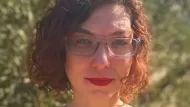A ten-block area in one of L.A.’s most heat-prone neighborhoods saw significant reductions in surface and air temperature thanks to an innovative street treatment that could help communities around the country mitigate the impacts of extreme heat.

Following up on a story Planetizen shared last August, Planetizen editor Diana Ionescu spoke with Jeff Terry, VP of CSR & Sustainability at GAF about new data that shows the quantifiable impacts of the GAF Cool Community initiative undertaken in Pacoima, a community in the San Fernando Valley in Los Angeles, California.
According to Terry, a year after the application of 700,000 square feet of a reflective street treatment in a 10 square block area, the treatment was found to reduce surface level temperatures by as much as 10 degrees and ambient air temperatures by around 1.5 degrees on sunny days, with a reduction of up to 3.5 degrees on the most extreme days. The epoxy acrylic coating, whose maintenance schedule Terry says lines up with the average lifespan of street pavement, lightens the surface and helps prevent heat absorption into hard surfaces, so the pavement warms up more slowly and cools down faster. Anecdotally, Terry says park staff reported being able to schedule more activities thanks to more comfortable spaces.
The project is a partnership between Global Cool Cities Alliance, Climate Resolve, GAF, Pacoima Beautiful, Urban Semillas, Councilwoman Monica Rodriguez, StreetsLA, LA Department of Recreation & Parks, and the Los Angeles Unified School District—a broad coalition of local entities coming together to implement the project across different properties. Terry praised the community-wide approach taken by Pacoima, which can provide more effective cooling at a larger scale, particularly when projects move beyond cool pavements to cool roofs and other innovations that fight the urban heat island effect.
The project is collecting data in the project area and a nearby neighborhood with similar temperatures, as well as gathering more subjective benefits such as outdoor comfort and heat awareness among residents. A ‘playbook’ created for the Pacoima project outlines the planning and implementation process and provides guidance for replicating the program in other communities.
The Pacoima project, Terry says, is an effective example of a public-private partnership that leveraged key relationships with community advocates, government partners, local elected officials, and individual residents to understand the community’s needs and provide information about the impacts of extreme heat. In Terry’s experience, the project was welcome by most stakeholders, but for many communities key challenges such as a lack of awareness and understanding of the true impacts of heat, a lack of funding that addresses the urgency of cooling solutions, and the difficulty of coordinating among different agencies and property owners remain.
As extreme heat becomes a top public health risk, officials are building a growing toolkit for combating the effects of heat and retrofitting cities with green spaces, cool surface treatments, and sustainable infrastructure that can withstand heat, fire risk, and high power demand.

Plan to Potentially Remove Downtown Milwaukee’s Interstate Faces Public Scrutiny
The public is weighing in on a suite of options for repairing, replacing, or removing Interstate 794 in downtown Milwaukee.

‘Forward Together’ Bus System Redesign Rolling Out in Portland
Portland is redesigning its bus system to respond to the changing patterns of the post-pandemic world—with twin goals of increasing ridership and improving equity.

Can New York City Go Green Without Renewable Rikers?
New York City’s bold proposal to close the jail on Rikers Island and replace it with green infrastructure is in jeopardy. Will this compromise the city’s ambitious climate goals?

700-Acre Master-Planned Community Planned in Utah
A massive development plan is taking shape for lakefront property in Vineyard, Utah—on the site of a former U.S. Steel Geneva Works facility.

More Cities Ponder the End of Drive-Thrus
Drive-thru fast food restaurants might be a staple of American life, but several U.S. cities are actively considering prohibiting the development of new drive-thrus for the benefit of traffic safety, air quality, and congestion.

Air Pollution World’s Worst Public Health Threat, Report Says
Air pollution is more likely to take years life off the lifespan of the average human than any other external factor, according to a recent report out of the University of Chicago.
Placer County
City of Morganton
HUD's Office of Policy Development and Research
Dongguan Binhaiwan Bay Area Management Committee
City of Waukesha, WI
Los Angeles County Metropolitan Transportation Authority
Indiana Borough
Write for Planetizen
Urban Design for Planners 1: Software Tools
This six-course series explores essential urban design concepts using open source software and equips planners with the tools they need to participate fully in the urban design process.
Planning for Universal Design
Learn the tools for implementing Universal Design in planning regulations.




